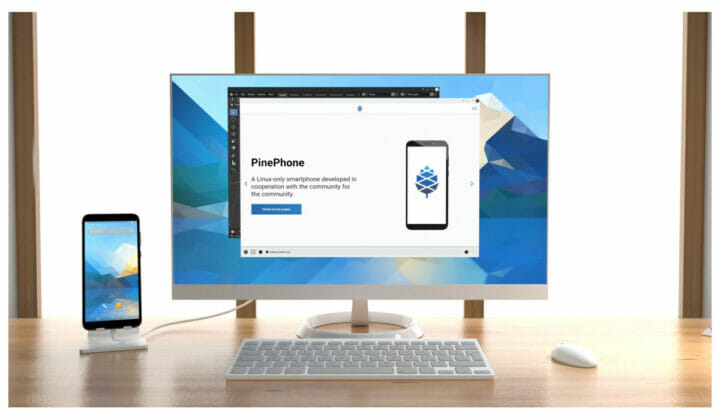Pine64 has now announced the PinePhone Pro Linux smartphone with a Rockchip RK3399S hexa-core processor clocked at 1.5 GHz, that’s a power-optimized version of the popular Rockchip RK3399 processor. It will provide a noticeable upgrade to the PinePhone Linux smartphones launched in November 2019, which, by today’s standards, is quite underpowered.
Besides the faster processor, PinePhone Pro also comes with 4GB RAM and 128 GB storage which should make it a better candidate at mobile desktop convergence, as well as a 5.95-inch display with 1440×720 resolution, a 13MP rear camera, a 5MP front-facing camera, and more.
- SoC – Rockchip RK3399S with an hexa-core processor comprised of 2x Cortex-A72 core @ up to 1.5 GHz, 4x Cortex-A53 cores, Arm Mali T860 quad-core GPU @ 500Mhz
- System Memory – 4GB LPDDR4 @ 800MHz
- Storage – 128GB eMMC flash storage, MicroSD slot
- Display – 5.95-inch 1440 x 720 in-cell IPS with Gorilla Glass 4
- Cameras
- 13MP Sony IMX258 main camera with Gorilla Glass 4 protective layer
- 5MP OmniVision OV5640 front-facing camera
- Audio – Built-in microphone, speaker, 3.5mm audio jack
- Connectivity
- Quectel EG25-G for global 4G, CDMA and GSM bands, GPS, GPS-A, GLONASS (Same as the original PinePhone)
- Dual-band 802.11b/g/n/ac WiFi 5 and Bluetooth 4.1 via Ampak AP6255 wireless module
- USB – USB-C 3.0 port for power, data, and DisplayPort Alt. mode
- Sensors – Accelerator, Gyroscope, Proximity, Compass, Ambient light
- Expansion – Pogo pins compatible with the original PinePhone
- Debugging – UART via 3.5mm audio jack
- Misc
- Privacy hardware switches for cameras, microphone, WiFi and Bluetooth, LTE modem (including GPS), and headphones (to enable UART output)
- Volume up / down rocker, and Power button
- Flash / Torch function
- Vibration motor
- Status LED
- Battery – Samsung J7 form-factor 3000mAh
- Power Supply – 5V/3A (15W) via USB-C port with Quick Charge (USB PD) function
- Dimensions – 160.8 x 76.6 x 11.1mm (about two millimeters thicker than PinePhone)
- Weight – Approx. 215g (vs 185 grams for the original PinePhone)
 I really thought the next PinePhone would come with a Rockchip RK3566 processor because of the higher efficiency of the Cortex-A55 cores together with the 1.8/2.0 GHz CPU frequency delivering higher performance than the Allwinner A64 quad-core Cortex-A53 processor @ 1.2 GHz. But instead, Pine64 collaborated with Rockchip to fine-tune the RK3399 SoC’s performance so that it meets the necessary thermal and battery-consumption envelopes, as and as a result, RK3399S was born. Pine64 also explained Rockchip helped a great deal in enabling the PinePhone Pro’s suspend state, which allows the smartphone to receive calls and SMS messages while preserving the battery.
I really thought the next PinePhone would come with a Rockchip RK3566 processor because of the higher efficiency of the Cortex-A55 cores together with the 1.8/2.0 GHz CPU frequency delivering higher performance than the Allwinner A64 quad-core Cortex-A53 processor @ 1.2 GHz. But instead, Pine64 collaborated with Rockchip to fine-tune the RK3399 SoC’s performance so that it meets the necessary thermal and battery-consumption envelopes, as and as a result, RK3399S was born. Pine64 also explained Rockchip helped a great deal in enabling the PinePhone Pro’s suspend state, which allows the smartphone to receive calls and SMS messages while preserving the battery.
In a way, it makes perfect sense, as Rockchip RK3399 is well supported in mainline Linux, while RK3566 and RK3568 will require more work before most/all features are implemented. The new PinePhone Pro keeps many of the same features as the original PinePhone including a similar display (albeit slightly thicker), the same pogo-pin systems and back cover attachment as the original PinePhone, making it compatible with all existing add-ons, including the keyboard, PineDio LoRa, fingerprint reader and wireless charging cases.

The default operating system for the PinePhone Pro is Manjaro Linux with KDE Plasma Mobile, but most if not all of the operating systems already available PinePhone should eventually be supported, and more may come. When asked about battery life, Pine64 did not have power consumption numbers to provide yet, but one should expect battery life to be equivalent or better than for the PinePhone for both on-screen time and standby.
Just like most Pine64 products, the PinePhone Pro will rely on work from the community for software support, and the first PinePhone Pro devkit is up for pre-order for $399 plus shipping and eventual import taxes now with a clear focus on developers and established contributors, although newcomers with an established development record can also pre-order. Tech enthusiasts without a developer background are asked to wait a couple of more months for the second batch of PinePhone Pro “Explorer Edition” that is scheduled to be manufactured before the end of the year, and ship in early 2022. Additional information may also be found on the product page.

Jean-Luc started CNX Software in 2010 as a part-time endeavor, before quitting his job as a software engineering manager, and starting to write daily news, and reviews full time later in 2011.
Support CNX Software! Donate via cryptocurrencies, become a Patron on Patreon, or purchase goods on Amazon or Aliexpress. We also use affiliate links in articles to earn commissions if you make a purchase after clicking on those links.







It is a shame that financially in trouble Unisoc have no open Linux interest or support. The tablet SoC T610, T618 would be interesting phones.
Anyway anyone got benchmarks for 1.5Ghz limited RK3399 to share, so as to indicate what to expect ?
I hope Qin F21 Pro on the T310 chip,
f21prosprd, makes it to the market. Would be a funny device to run a custom kernel on. The chip itself seems to ship with Linux 4.19, nothing mainline of course.Does it come with free oven mitts?
Pop goes peoples bubbles .
The power profile should be similar to Allwinner A64 with RK3399S clock to 1.5 GHz and voltage limited. So we’ll see what they can do with it.
Quectel EG25-G – known as the modem that can’t wait itself soon enough to let people answer the call.
Just don’t buy it. It’s a waste of money.
@CNXsoft
Not sure if you will allow this and not open software, but there are non phone Rockhip handhelds already, available here http://armdesigner.com/RK3399_Handheld_Device/
Other Rockchip SoC designs too !
Thinking about it, the Steam Deck will probably be the better docked Linux experience, i.e. a “portable desktop”. It’s also the same price, $400, but with quadruple the RAM. It’s not a phone, but it does have two microphones on it.
hopefully it will be compatible with your own keyboard case from the ‘old’ Pinephone.
They confirmed it will be
thx 4 info
To me this sounds more like a last gasp attempt by Rockchip to squeeze extra life out of its RK3399 series rather than a conscientious effort by Pine64 to base a smartphone around a 6 year old GPU.
At the launch of Quartz64 they said it had all the necessary ‘devkit’ interfaces to support any future non-Pro devices, so here’s hoping an 8GB RK3566 PinePhone 2 with 5G will be released with minimal fanfare when it’s ready! 🙂
RK3588 PinePhone Pro 2 :O
> when it’s ready!
5 years from now on? You know the joke called ‘Linux mainline support for a new ARM SoC’? It’s finished once the hardware is obsolete.
As such RK3399S seems a reasonable choice as long as these SoCs are not just the result of Rockchip QA relabeling wafers that fail with the A72s above 1.5Ghz but are really made for lower DVFS OPP allowing for real savings (whether the phone’s software makes any good use of this is a totally unrelated question).
And you are right.. sadly, we are never a priority. That’s why I don’t care about new gen arm socs, but on riscv socs. There we could be a much better treated community….
HW specs without support is useless.
Doesnt matter if rk3588 is a monster, what matters is that even with the display driver and all the stuff resolved on mainline (several month’s later) if the cpu cores will have to handle video playback, then its much preferably x86_64 linux platforms for desktop.
In order to be competitive we need good display driver support (all the resolutions), good gpu (mesa) and vpu drivers that work inside the desktop and not on shityelec… without that, we are not competitive… even with low end x86_64 platforms..
And if arm linux platforms cant provide this (bc of lack of vendor interest), then we need to move along arm and shift to riscv.
Even with less power, supported hardware on linux is what we need.. a vpu working on mainline linux on riscv platforms can make rk3588 obsolete on day 1, even if they do not perform as greatly on other tasks.
Yeah, video playback isn’t the only feature of a desktop pc… but it’s a very important one.
Also, I don’t know in which terms you left armbian, but would be cool to have you back, at least on our discord.(yes, armbian now have a discord server!)
RISC-V and Arm Linux support will probably be similar, and it may even be more complicated with RISC-V due to custom instructions. Switching to RISC-V will not magically make GPU, VPU, etc… work out of the box.
The main advantage of RISC-V is that it lowers the barrier to entry thanks to some open design available and no royalties, so there may be more companies designing SoCs for niche / specific applications.
Yeah, but the main difference is the target. What market will target riscv platforms? Mobile phones? No, linux. Whoever make a riscv platform and use whatever vpu engine will ensure that the vpu works in mainline as expected, not like rockchip giving us vpu with a very old forked kernel. The same with the gpus.
It’s time to admit the elephant in the room. x86 is resurgent and is the better option for most people. AMD’s Ryzen and Intel’s working 10nm broke the dry spell of the mid-2010s. Power efficiency is much better, with good options in the 5-35 Watt range. Intel is going to have a hit with Alder Lake, and both Intel and AMD have more tricks in the bag.
Both companies have paths to target SBCs. Intel could pump out an infinite number of 1+4 Alder Lake ultra mobile chips, which is half of the 2+8 die. AMD has the small Van Gogh die, and might make a cheaper Monet Zen 3 die at GlobalFoundries.
RK3588 is late to the party. RISC-V can become just as much of a fragmented mess as ARM, if not more so.
And probably you are right
How is your AMD, Intel phone doing?
Are you going to die on the beach?
The all new PinePhone Pro allows me to die on the go, wherever I please.